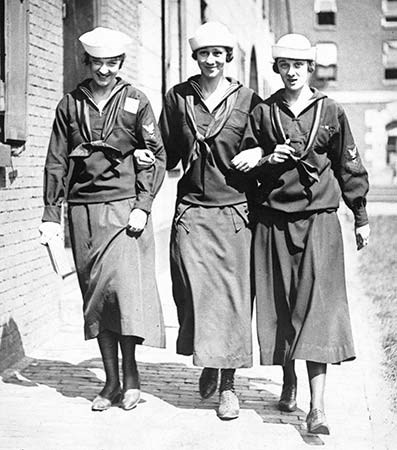Last updated: March 8, 2023
Article
Women Workers at the Boston Navy Yard during World War I

Names from The Illustrated War News, 1918. Image courtesy of Encyclopædia Britannica, Inc.
In spring of 1917, more than two years before the 19th Amendment granted women the right to vote, a radical transformation was taking place at the Boston Navy Yard. The US Navy adopted a radical enlistment policy that opened its clerical ranks to educated, white women. Parallel to this national watershed, the Boston Navy Yard (now known as the Charlestown Navy Yard) hired civilian women as unskilled laborers for the first time in its history.
In January of 1917, the quarter-mile long granite ropewalk at the Boston Navy Yard was producing rope and cable for the entire US Navy using hand-powered, 19th-century machinery. By December of 1918, the ropewalk, the only government-owned plant that manufactured the various kinds of rope used in the Navy, had sped up production to meet national demand for its products. As the Yard newspaper, The Salvo, proudly related, 232 steam-run spindles now manufactured yarn from Manila or American hemp, long enough to stretch from the Earth to the Moon and back again.

NPS Photo
The coming of industrial-era machinery to the ropewalk not only increased production, but opened up light manufacturing jobs to unskilled laborers. The Boston Navy Yard quietly broke with trade tradition and brought on 150 women to fill these new positions at the ropewalk facility. The ropewalk was the Yard’s only plant to employ women in industrial roles during World War I.
At present, we know very little about these women. It is possible that they, like many new hires of the time, were encouraged to apply for their positions by friends and relatives who already worked at the Navy Yard. The law stated that they would be paid the same rate as male unskilled laborers, $2.24 per day, increasing to $4.32 by late 1818.

US Naval Archives - Department of the Navy
Women also occupied skilled roles at the Boston Navy Yard during World War I. On March 21, 1917, all Naval District commanders were called on by Secretary of the Navy Josephus Daniels to open enlistment for the Yeoman (clerical) grade to women, who would be referred to as Yeoman (F). White collar work was already a boom field by the beginning of the twentieth century, as administrative, communications, and clerical functions became increasingly important in both industry and governance. With the United States on the brink of war, US Navy planners knew that their male clerks of the Yeoman rating would be sent to sea with the fleet. To Secretary Daniels’ mind, inviting women with the right education and experience to enlist in the Naval Reserve was the solution. However, Secretary Daniels made it clear that no African American women were to become Yeomen (F); one case of an African-American woman being denied the chance to enlist in Boston was recorded in a history of the First Naval District.
At the Boston Navy Yard, Commander William R. Rush was building his administrative staff to run a facility that would soon triple its workforce. As more experienced male Yeomen were sent off to sea, educated Yeomen (F) with job experience were a welcome addition to the team with its relentless 6-day, 60-hour workweek.
Many Boston women rushed to enlist for duty as Yeomen (F), like Emily Steele who, upon her enlistment in March 1917, was immediately designated secretary to the First Naval District commander and assumed duties the next day. Many of the new Yeoman (F) came from families with deep ties to the US Navy. All were high school graduates, some had attended clerical training schools, some were college graduates, and some offered years of valuable work experience. In March 1918, Boston enlistment for Yeomen (F) was capped, as supply had come to exceed demand. Throughout the war, Boston newspapers reported on charity events, uniform and deportment competitions, war bond drives, sporting events, all coordinated by Yeomen (F) at the Navy Yard. A core team of these women, associated with the Commandant’s office, became Head Yeomen (F) and took on leadership functions in many of these activities.
Boston Navy Yard quickly fitted out an office space “for a corps of a dozen young women, who will be enrolled as soon as they pass the examination.” By May 1918, several hundred women served as Yeomen (F) in offices at Boston Navy Yard and other U.S. Navy offices in Boston. Commander Rush singled them out for praise on the occasion of the funeral of Capt. Samuel Nicholson, the first commandant of the Boston Navy Yard, saying that “their devotion to duty, zeal and efficiency is beyond praise.”
